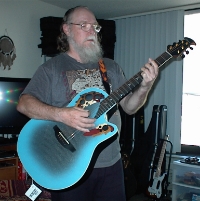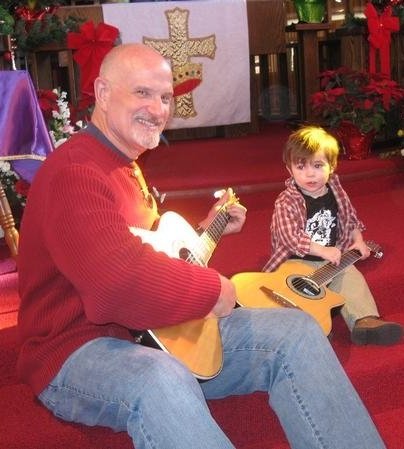|
|
Joined:
August 2007
Posts: 71
Location: Southern California | I am curious about these. What exactly is it that you do with them. I mean I see them fitted across the fret board, but I don't really understand what it does.
Any info would be much appreciated.
And what capos fit ovation guitars?? |
|
| |
|
Joined:
June 2002
Posts: 863
Location: Central Florida | The capo allows you to raise the pitch of the open strings, thereby allowing you to play in one key, while actually fingering in another. For instace, if a song is in in the key of Eb (which isn't a very guitar friendly key), you can place the capo at the first fret and do the fingering positions for D, but since you've raised the pitch a half-step, you're actually playing in Eb; or, put the capo at the third fret and play in the same key (Eb) by using the C position fingering. It's sort of like having the ability to move the nut up and raise the pitch of the guitar at the same time.
I know that's not a very "technical" explanation, but I hope it makes some sense. As for what capos are best for an Ovation, you'll get several recommendations, but FWIW, I use Kaisers myself. |
|
| |
|

Joined:
September 2006
Posts: 10777
Location: Keepin' It Weird in Portland, OR | I got a Planet Waves NS Capo. I like it... Alot. It has no spring, so it isn't quick cange. But it is nice and light, and small, and adjustable, so you don't have to cut grooves in your frets. You can get them for about $15 (shipped) if you shop around.
More info

Smarter members will give you advice on their usage... :rolleyes: |
|
| |
|
Joined:
March 2005
Posts: 2791
Location: Atlanta, GA. | From Wikipedia:
A capo (short for capotasto, Italian for "head of fretboard") is a device used for shortening the strings, and hence raising the pitch, of a stringed instrument such as a guitar, mandolin or banjo. It was invented by the Flamenco guitarist Jose Patino Gonzalez.
Basic capo...

Educational, Huh! |
|
| |
|

Joined:
August 2005
Posts: 3736
Location: Sunshine State, Australia | I use a Shubb.

but a lot of 'pros' (a description that would exclude me :( ) use Kaisers for their quick change ability. They work like a clothes peg and you often see them attached to the headstock when not in use.

I have also been known to use the pencil and rubber band method
Whatever works. |
|
| |
|

Joined:
December 2004
Posts: 4394
Location: East Tennessee | I use a capo a lot since I tune down to D.
Shubb, Kyser, Planet Waves, Paige, Dunlop are all pretty good.
I've not tried the G7 but have heard it is the BMW of capos. Priced like it too.
Lately I've been using "The Glider" a gift from Trader Jim. With it you can use your thumb to move the capo up and down the fretboard. :cool:
BTW; I think we all have used the pencil and rubber band method. |
|
| |
|
Joined:
March 2005
Posts: 5567
Location: Blue Ridge Mountains | Whatever works.
Exactly!
:D |
|
| |
|

Joined:
February 2002
Posts: 1817
Location: Minden, Nebraska | Tried 'em all, and I've stuck with Shubbs. |
|
| |
|
Joined:
May 2003
Posts: 4389
Location: Capital District, NY, USA Minor Outlying Islands | Shortens scale. I use them so I can play familiar chord shapes on other parts of the fret board, but change key.
I use shubbs.
I really recommend the Denier (sp) guitar handbook and the Guitar Player:Repair guide by erlwine (sp). They both have a lot of info you might find useful. And you'll save yourself a lot of time wondering how to do stuff. I wish someone had told me about them when I started. (though I think at that time they didn't exist!) |
|
| |
|

Joined:
September 2006
Posts: 10777
Location: Keepin' It Weird in Portland, OR | The pencil-trick works best on Classical flat necks...

For a standard neck, I recommend a PaperMate Flexgrip pen. It bends to the contour of the fretboard. :rolleyes: |
|
| |
|
Joined:
August 2007
Posts: 71
Location: Southern California | ok, this may be a stupid question, but how do you know WHERE to put it for WHICH key & how do you know what fingering to use for the chords with it like that? Is there a way to get this information in a simple straightforward fashion? Am I just dumb? It seems a bit complex to me............ |
|
| |
|
Joined:
August 2007
Posts: 71
Location: Southern California | Originally posted by an4340:
Shortens scale. I use them so I can play familiar chord shapes on other parts of the fret board, but change key.
I use shubbs.
I really recommend the Denier (sp) guitar handbook and the Guitar Player:Repair guide by erlwine (sp). They both have a lot of info you might find useful. And you'll save yourself a lot of time wondering how to do stuff. I wish someone had told me about them when I started. (though I think at that time they didn't exist!) I do have a "guitar handbook" that is full of info, some of it a bit complex for me at the moment, but I will have to look into these as well. |
|
| |
|

Joined:
September 2006
Posts: 10777
Location: Keepin' It Weird in Portland, OR | Just trying to be helpful...
Using a Capo
The Unappreciated Art Of Using a Capo
eHow to use a Capo |
|
| |
|
Joined:
August 2007
Posts: 71
Location: Southern California | I'll check those out, thanks! |
|
| |
|
Joined:
August 2005
Posts: 22
Location: Ky | Another benefit of capos is, if you have a crappy voice like mine with no range, and can't ever hit the "high" notes -by raising the pitch with the capo, you actually lower the key you're playing in, at least in terms of your voice. Someone else who knows more about music than me can maybe explain how this works. All I know is, if you find yourself straining to sing a song in A minor (standard tuning), just pop the capo on about the 4th fret, and voila! -your puny voice can handle it. Likewise, if it seems to low for your voice to work, try about the 2nd fret or so -whatever works -and you can make your voice more flexible than you ever thought it was. Plus, if your buddies know a song in a certain key and you know it in a different one, play around with a capo, until they match up. Saves re-learning a song with different chords. |
|
| |
|
Joined:
November 2004
Posts: 382
Location: USA | I use my capo faithfully...I would be lost without it :) |
|
| |
|

Joined:
January 2006
Posts: 5881
Location: Colorado Rocky Mountains | I've gotten away from using a capo over the past six months, maybe only once a month or so based on the picking style required for a particular number. One problem is that I forget its there and then "Surprise!" when the next number begins. I have a Shubb, Kyser and several others, but prefer the Victor. Its simplicity and single screw tightener works almost as fast as the Shubb and Kyser. It was interesting to watch Glen Campbell use a capo when he came into town. My recollection is that he used a D chord fingering pattern and adjusted the capo accordingly to fit the key. |
|
| |
|
Joined:
April 2006
Posts: 972
Location: PDX | Originally posted by fishchick72:
ok, this may be a stupid question, but how do you know WHERE to put it for WHICH key & how do you know what fingering to use for the chords with it like that? Is there a way to get this information in a simple straightforward fashion? Am I just dumb? It seems a bit complex to me............ Well, it is pretty easy, ONCE you know your fretboard. So you really have to start there. The CAGED system is a good start -- look it up on the web, there's lots of good introductions to be found.
If you are playing some pop tune in the Key of A, for example, odds are the chords you are playing are A D and E. Which are the I, IV, and V chords in the key of A If you want to change to the Key of C you put your capo on the third fret. The I IV and V chords in the key of C are C F and G.
Why? Because the A chord SHAPE [oo222o] moved up to the third fret [335553] produces a C chord.
The E SHAPE [o221oo] moved up to the third fret [355433] produces a G chord.
The D SHAPE [xoo232] moved up to the third fret [x33565] produces the F chord..
Hope that helps.
_____
gh1 |
|
| |
|
Joined:
August 2007
Posts: 71
Location: Southern California | Interesting, thanks, I'm gonna have to look into that more. I'm not real clear on different keys & chords that go with what keys............... |
|
| |
|
Joined:
July 2004
Posts: 812
Location: Hicksville, NY | Originally posted by surfnguitar:
Another benefit of capos is, if you have a crappy voice like mine with no range, and can't ever hit the "high" notes -by raising the pitch with the capo, you actually lower the key you're playing in, at least in terms of your voice. Saves re-learning a song with different chords. Very good point and I agree.
I learned how to play Shawn Colvin's "Sunny Came Home" in A minor; standard tuning. But there's no way I could sing them high notes, so I placed the capo in the 4th fret, and still played it in Am. Lo and behold, despite my singing in a low pitch, the guitar accompaniment matches my vocals very well. :)
Strange but it works... |
|
| |
|
Joined:
August 2007
Posts: 71
Location: Southern California | I bought a book of music by David Crowder & at the beginning of the songs it gives you pointers like "tune down 1/2 key" or apply a capo to 3rd fret, etc. And I want to play around with one & see what it can do. So I am planning to get a capo soon. Probably on Friday or Monday I'll try to get one.
Should I take my guitar with me to make sure I get one that fits right?? |
|
| |
|

Joined:
December 2004
Posts: 4394
Location: East Tennessee | Get a Shubb and it will fit.
The Planet Waves NS is pretty good also.
If you have a lot of $$$ get the G7. |
|
| |
 Capos?
Capos? Capos?
Capos?